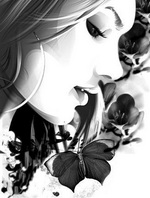 :: ::  |
| Autor |
Poruka |
Charmed
Malo ~ mače ~

 |
Datum registracije: 03 Avg 2004
Poruke: 14625
Mesto: Nije bitno ko je odakle bitno je ko je kakav covek

|
|

Beowulf - gaetski mitski junak
Anglosaksonci su pjesmu o Beowulfu pjevali davno prije nego je bila zapisana u 8. stoljeću, a priča koju će Vam napisati Athumanunh potječe iz 10. stoljeća. Anglosaksonci su potomci sjevernoeuropskih plemena koje su Briti pozvali 400. godine, nakon što su Rimljani napustili Britanski otok, da im pomognu u borbama protiv divljih škotskih plemena. Anglosaksonci su zapravo mješavina Angla, Saksonaca, Juta i Frižana. Ti Anglosaksonci nakon što su otjerali divlja plemena u negostoljubive planinske sjeverne krajeve Britanskog otoka, negdje oko 600. godine zaratili su i sa svojim domaćinima Britima, te im oteli velike dijelove Britanskog otoka. No, Anglosaksonci nisu bili naviknuti na maglom prekrivena glibovita i boćata jezera, pa su ubrzo nastale i prve legende i mitovi o strašnim čudovištima koja su vrebala iz tih jezera. Jednu takvu legendu sada će Vam napisati Athumanunh. 'Hrothgar, kralj Danaca, sagradio je u Heorotu golemu dvornicu za održavanje brojnih svečanosti na kojima je on dijelio zlatne narukvice svojim ratnicima i članovima družine. Tako se tijekom tih svetkovina pila medovina, nazdravljale se brojne zdravice, a bardi su pjevali o svima čudima ovoga Svijeta. Zvuci bučna veselja noćima bi se dizali pod nebesa s visokih rožnika dvornice. No, vani je vrebalo, u ustajalim vodama baruštine, zlo mitsko stvorenje imenom Grendel. Bio je Grendel opako čudovište, strah i trepet krajeva uz granicu, a zvuci svirke i ljudski smijeh nanosili su mu strašne i netrpljive bolove. Jednu za drugom noći Grendel je patio u bolovima sve dok jednom nije odlučio da provali u Heorot. Straža pred dvornicom bijaše zadrijemala, a u samoj dvornici kraljeva družina drijemala je shrvana veselicom i teških glava od bijelog piva, s trbusima punim raznih jestvina. Grendel im pregrize vratove i poput zaklane stoke odvuče ih u svoju jazbinu. Tako je punih dvanaest godina Grendel provaljivao u Horthgarsku dvornicu i odvlačio najvjernije kraljeve ljude. Nitko od inih ratnika nije se usudio suprotstaviti strašnom Grendelu, sve dok nije odnekuda pristigao mitski gaetski junak Beowulf. Ubrzo je Beowulf obznanio da će on ubiti strašnog Grendela ili će i sam umrijeti u njegovoj jazbini. Kraljev mitski ratnik Unferth odgovarao je Beowulfa od njegovog nauma, ali je on ipak te noći goloruk i nenaoružan dočekao u zasjedi Grendela. Nakon kraćeg hrvanja, uz strašan, gnjecav zvuk trganja mesa, Beowulf iščupa Grendelu jednu moćnu šapu. Grendel urlajući i zavijajući od bola pobjegne u mrak. Nastane veliko veselje, ali je ono bilo preuranjeno. Naime već te iste noći iz mraka izroni još strašnije čudovište i još opakije stvorenje, a bila je to majka Grendelova koja je te noći usmrtila najboljeg kraljevog odličnika Aeschera. No, Beowulf i Unferth sada su slijedili čudovište u mrak i saznali u kojem se jezeru ono krije. Kad je Beowulf odlučio zaroniti u tamne vode jezera Unfert mu pokloni svoj mitski mač Hrunting koji nije nikada mogao promašiti. Beowulf je zaronio u duboko jezero, a strašno ga čudovište odjednom iz mraka dohvati svojim čeljustima. No, nije ga moglo povrijediti jer je Beowulf nosio oklop načinjen od metalnih prstenova. Beowulf udari čudovište mačem, pogodi ga, ali mač nije mogao probiti krljušti. Tada Beowulf ugleda veliki mač koji je davno prije pripadao nekom divu, on ga podigne i njime udari čudovište. Vode jezera proključale su krvlju, kraljevi ljudi koji su stigli na jezero, žalosno su zaključili da je Beowulf mrtav. No, nije bilo tako, jer se ubrzo na površini jezera pojavio Beowulf noseću u rukama glavu Grendela i njegove majke. Nastane silno veselje i bučne gozbe koje potrajaše nekoliko dana. Nakon tih gozbi i bogatih darova koje mu je poklonio Hrothgar, Beowulf i njegovi ljudi iznova porinu svoj brod stazom galeba, tragom kita, natrag u zemlju Gaeta, gdje je Beowulf još dugo imao kraljevati.'
|
_________________
Pre nego sto se dodje do brzopletog zakljucka i pre nego sto se pocne misliti lose, Gledaj sa paznjom detalje, vrlo cesto situacija nije onakva kako izgleda nama na prvi pogled!!!! |
|
| |
|
 |
Annabel_Lee
ஐ NaUgHtGeLiC ஐ

 |
Godine: 43
Datum registracije: 02 Feb 2005
Poruke: 30310

|
|
EOSTRE
Eostre is the name of a putative goddess of the Anglo-Saxons who is also worshipped by some neopagans. The Venerable Bede described her worship as something which had already died out by the time he began writing the first significant history of the Anglo-Saxons. In recent years some historians have suggested that Bede may have made her up because there are no known references to her preceding his work. Others point out that Bede is known as "the Father of English history" precisely because he has long been the source for most of what little we know about pre-Christian English history.
Modern sources associate her with various aspects related to the renewal of life: spring, fertility and the hare (allegedly for its rapid and prolific reproduction). Modern worshippers and writers describe Eostre as a "goddess of Dawn" based on the etymological relationship between her name and the Anglo-Saxon word for 'dawn'. Some Neo-pagans believe that she was sometimes depicted with a hare's head, though it is not possible to substantiate this belief as no known animal-headed deities appear in Germanic or Celtic cult objects. There are no known Celtic depictions of Eostre whatsoever.
Bede's account of Eostre
According to Bede (c. 672 - 735), writing in De Tempore Ratione ("On the Reckoning of Time"), Ch. xv, "The English months", the word is derived from Eostre, an Anglo-Saxon goddess of spring, to whom the month answering to our April, and called Eostremonat, was dedicated;
"Eosturmonath has a name which is now translated "Paschal month", and which was once called after a goddess of theirs named Eostre, in whose honour feasts were celebrated in that month. Now they designate that Paschal season by her name, calling the joys of the new rite by the time-honoured name of the old observance."
What is secure in Bede's passage is that the lunar month around the month of April in the Julian calendar was called the Eostre-monath. And as the Christian tradition of Easter, which has also fallen in April, arrived in some Germanic-speaking regions, the people named the then-unnamed Christian day after the festival, that is, in English as Easter, and in German as Ostern. It is alleged that remnants of Eostre's characteristics can also be found in the Easter Bunny celebrations, based on Jacob Grimm's research into connections between the 'Ostern Hare' and the Germanic Ostara, which he believed to be another name for the same goddess.
Those who question Bede's account of a goddess have not suggested any alternative explanation for who or what the 'Eostre' in "Eostre's Month" might have been. The same lack of information which allows Bede's account to be questioned also makes it impossible to disprove, ultimately meaning that it cannot be accepted 'prima facie', as has often been done in popularized "histories".
Eostre in Grimm's Deutsche Mythologie
In 1835, Jacob Grimm (1785 - 1863) published Deutsche Mythologie, a collection of German myths and oral histories, including extensive commentary on Ostara traditions in Germanic lands. Grimm suggested that various place names in the German Confederation were derived from Ostara's worship, noted the etymological connection between 'Eostre' and 'Ostara', and listed various traditions. Amongst these were the Ostern Hare, Ostara eggs, the Ostara sword, hilltop ceremonies at dawn, and other examples of traditions he believed to be derived from the past worship of Ostara.
The name Ostara was handed down in the German oral traditions Grimm was recording and he indicated that it was held to be the name of an old goddess, but no earlier texts stating this are known. Grimm suggested that the parallels between the names 'Eostre' and 'Ostara', months 'Eostremonat' and 'Ostaramanoth', and holidays 'Easter' and 'Ostern' implied a common origin.
As with Bede, there is no ancient textual proof of Grimm's assertions, but no evidence for an alternative explanation of what "Ostara's Month" might have referred to has been put forward, thus excluding either interpretation from the realm of factual account.
Etymology of Eostre
Many linguists agree that Eostre and Ostara are derived from the Old Teutonic root 'aew-s', 'illuminate, especially of daybreak' and closely related to (a)wes-ter- 'dawn servant', the morning star Venus and *austrôn-, meaning "dawn".
Similar words, which it has been suggested are variations of Eostre's name, include Ostare, Ostara, Ostern, Estre, Eostre, Eoster, Eostra, Eastre, Eostur, Eastra, Eastur, Austri, Austron, Aurora, and Ausos. There is no certain parallel to Eostre in Old Norse though Grimm speculates that a "spirit of light" named Austri from the Eddas might be related.
Speculative alternative etymologies
The word oestrogen is sometimes incorrectly believed to have been derived from Eostre. This almost certainly results from a train of thought involving the hormone oestrogen, human egg cells, Easter eggs and fertility.
However, oestrogen actually derives directly from the word oestrus. The meaning of oestrus comes directly from Greek language oistros, originally referring to a "gadfly"— specifically the gadfly that Hera sent to torment Io, who had been wooed and won in her heifer form by Zeus. Homer uses the word to describe the panic of the suitors in Odyssey book 22. The modern technical Latin meaning of estrus became more prominent after it was revived in 1890 to describe the female equivalent of "rut": hence "estrogen", the "hormone that generates oestrus".
Oestrus/oistros also meant "frenzy". Euripides uses it both to describe the madness of Orestes and that of Heracles. In x (line 1144), Heracles has murdered his own children and cries, 'Where did the madness seize me? Where did it destroy me?'
More to the point, Herodotus (Histories ch.93.1) uses oistros to describe the desire of fish to spawn.
Oestrus is an irrational drive: Plato, Laws, 854b:
“My good man, the evil force that now moves you and prompts you to go temple-robbing is neither of human origin nor of divine, but it is some impulse bred of old in men from ancient wrongs unexpiated, which courses round wreaking ruin; and it you must guard against with all your strength."
In the Republic, Plato again uses the word, to describe the soul "driven and drawn by the gadfly of desire".
The earliest English language sense is of "frenzied passion."
The name Eostre also bears some resemblance to the name Ishtar, a Babylonian goddess. Other variants on Ishtar include Astarte and Ashtoreth. This resemblance has resulted in some Neopagans and Christians opposed to Easter believing that Easter is Ishtar's festival. (Fakelore is often constructed to support such speculative continuities.) There is, however, no evidence that Ishtar was ever worshipped in Europe, nor any strong evidence that the myths of the two goddesses were related.
Some of the most determined proponents of an Ishtar/Easter connection are not Neopagans but certain fundamentalist Christians, notably Ralph Woodrow, whose Babylonian Mystery Religion includes the Easter/Ishtar hypothesis and condemns the celebration's trappings as unChristian. This is a curious example of Christians and neopagans alike supporting theories of a continuity of Goddess worship in the absence of any conclusive evidence.
Jacob Grimm noted this similarity in names and speculated on a possible connection based on this and some minor similarities in rites attributed to the two goddesses. It is also sometimes suggested that a link between the two goddesses might have been made through Greek Aphrodite / Roman Venus. In support of this theory some cite that Indo-European '(a)wes-ter' and Semitic 'istrt', roots to which the two names were closely related, both referred to the planet Venus, which of course was also associated with the Roman goddess of the same name.
A distracting apparent early reference to 'Easter' in the King James Version of the Bible translation of the New Testament, Acts of the Apostles 12:4, is simply an anachronistic mistranslation of the Greek pascha ("Passover"), in which the committee of James I of England followed such earlier translators as William Tyndale and Myles Coverdale. The Acts passage refers to the seven-day Passover festival (including the Feast of Unleavened Bread); "it is reasonably certain that the New Testament contains no reference to a yearly celebration of the resurrection of Christ."
Beliefs and Practices Associated with Eostre
Most modern sources describe Eostre's festival as a celebration of the Spring Equinox. Bede, however, never stated this. He equated the 'Eostur-monath' with April. Since the Spring Equinox falls on a single date in March rather than April some question the association. However, as Bede himself noted, the Anglo-Saxon calendar was based on a lunar cycle. Thus, the fourth month of 'Eostremonat' would actually have begun late in what we now call March and might thus have been associated with the equinox.
The association of Eostre with the Spring Equinox is important in neopagan belief as part of the Wheel of the Year. Neopagan celebrations of the Equinoxes involve goddesses from diverse cultures.
The belief that Eostre had hare's ears or a hare's head may well derive from Nigel Pennick's Practical Magic in the Northern Tradition in which an image of the Saxon moon god Mona from A Restitution of Decayed Intelligence is shown, with the accompanying text describing Mani both as a Goddess and as 'Eostre in her spring guise' [1].
Eostre in modern fiction, movies, etc.
Eostre plays a role in the novel American Gods by Neil Gaiman.
|
_________________
ƸӜƷ Tread softly because you tread on my dreams ƸӜƷ |
|
| |
|
 |
Annabel_Lee
ஐ NaUgHtGeLiC ஐ

 |
Godine: 43
Datum registracije: 02 Feb 2005
Poruke: 30310

|
|
Frige
Frige (Anglo-Saxon, Friia (Germany) or Frea (Langobard)) was the love goddess of Germanic mythology, and the wife of Wotan (Odin). She has given her name to the weekday Friday in analogy with Venus. In the last surviving and by far best known version of Germanic mythology, Norse mythology, she had split into two clearly related goddesses, the promiscuous Freya who was married to Odr and the sometimes unfaithful Frigg who was the wife of Odin.
|
_________________
ƸӜƷ Tread softly because you tread on my dreams ƸӜƷ |
|
| |
|
 |
Annabel_Lee
ஐ NaUgHtGeLiC ஐ

 |
Godine: 43
Datum registracije: 02 Feb 2005
Poruke: 30310

|
|
HENGEST
Hengest or Hengist (d. 488?) was a semi-legendary ruler of Kent in southeast England.
The facts of his life are unknown, but according to Bede (writing nearly 200 years after the events in question), he and his brother Horsa were mercenaries for the British ruler Vortigern, hired to fight against the Picts. Following his victories over the Picts, Hengest invited more immigrants from Germany to settle in Britain and then rebelled against Vortigern because the Britians refused to make an agreed payment, establishing himself as king in Kent. Both Hengest and Horsa are described as being Jutes, and sons of a Jutish chief named Wihtgils.
The actual historical existence of both Hengest and Horsa has been called into question numerous times, with many historians labeling these two as legendary 'divine twins' or culture heroes along the order of Romulus and Remus. It is perhaps more likely that Hengest, meaning 'Stallion' in Old English (in modern German 'Hengst' is still the word for a stallion), was an honorific for an actual warlord, while Horsa was a later accretion to the story, perhaps as a misreading of a gloss in a manuscript that was written to define the name Hengest as meaning 'horse'.
Later accounts in the Anglo-Saxon Chronicle, the Historia Britonum, Geoffrey of Monmouth's Historia Regum Britanniae, and Wace's Roman de Brut add further details from tradition and legend about Hengest's career. The Anglo-Saxon Chronicle dates his death to 488, but does not provide a cause; according to some tellings of the Arthurian legend, he was killed by the British king Uther Pendragon.
Hengest is the subject of the 1620 play Hengist, King of Kent, or The Mayor of Queenborough by Thomas Middleton.
Hengest is also a character in the Fight at Finnsburg narrative mentioned in the Finnsburg Fragment and the Beowulf poem. In these texts, Hengest is a Danish warrior who takes control of the Danish forces after the prince Hnæf is killed, and succeeds in killing the Frisian lord Finn in revenge for his lord's death. The events in these accounts had a historical basis, and have been supposed by historians to have occurred approximately 450 A.D. This makes these events contemporary with the Anglo-Saxon invasion of England, though what connection (if any) exists between the two Hengests is unknown.
Nevertheless, some have speculated that the two Hengests are one and the same. A point against this theory is the fact that one Hengest is described as a Jute and the other a Dane, though this does not serve as a conclusive disproof, as distinctions between adjacent groups (both Jutes and Danes lived in Denmark) were sometimes vague.
|
_________________
ƸӜƷ Tread softly because you tread on my dreams ƸӜƷ |
|
| |
|
 |
Annabel_Lee
ஐ NaUgHtGeLiC ஐ

 |
Godine: 43
Datum registracije: 02 Feb 2005
Poruke: 30310

|
|
WECTA
Wecta is mentioned in the Anglo-Saxon Chronicle and the Historia Britonum, and was a Jutish chieftain. His mother was Frigg (Frígídá) and his father was Woden.
He is considered mythological, though he shows up in genealogies as an ancestor of Hengest and Horsa and the kings of Kent.
|
_________________
ƸӜƷ Tread softly because you tread on my dreams ƸӜƷ |
|
| |
|
 |
Annabel_Lee
ஐ NaUgHtGeLiC ஐ

 |
Godine: 43
Datum registracije: 02 Feb 2005
Poruke: 30310

|
|
WEYLAND
Weyland (also spelled Wayland, Weland and Watlende) is the mythical smith-god of the Saxon immigrants into Britain. He is synonymous with the North-Germanic/Norse Völundr of the Völundarkviða, a poem in the Poetic Edda.
Weyland had two brothers, Egil and Slagfidur (or Slagfinn). In one version of the myth, the three brothers lived with three Valkyries: Olrun, Alvit and Svanhvit. After nine years, the Valkyries left their lovers. Egil and Slagfidur followed, never to return. In another version, Weyland married the swan maiden Hervor, and they had a son, Heime; Hervor later left him. In both versions, his love left him with a ring; in the former myth, he forged seven hundred duplicates of this ring.
At a later point in time, he was captured in his sleep by king Nidud in Nerike who ordered him hamstrung and imprisoned on the island of Saeverstod. There he was forced to forge items for the king. Weyland's wife's ring was given to the king's daughter, Bodvild. Nidud wore Weyland's sword.
For revenge, Weyland killed the king's sons when they visited him in secret, fashioned goblets from their skulls, jewels from their eyes, and a brooch from their teeth. He sent the goblets to the king, the jewels to the queen and the brooch to the kings' daughter. When Bodvild took her ring to him to be mended, he took the ring and seduced her, fathering a son and escaping on wings he made.
Weyland forged the sword Balmung, and the armor in which Beowulf fought Grendel. In Teutonic legend he is also said to have forged a sword for his son Heime that was wielded by Miming and then by Hodur. He is sometimes said to be the ruler of the dark elves (svartalfar).
He is particularly associated with Wayland's Smithy, a burial mound in Oxfordshire. This was named by the Saxons, but the megalithic mound significantly predates them. It is from this association that the superstition came about that a horse left there overnight with a small silver coin (a groat) would be shod by morning.
Watlende is also a Manor house in Kent.
The character "Weyland Smith" is prominent in the "Animal Farm" story arc of the Fables comic book. He is the administrator of "the Farm"---the rural property in upstate New York State where non-human-appearing Fables must live, to preserve the secret of their existence. He is briefly imprisoned as part of the abortive revolution against the Fabletown government, and is replaced as administrator by Rose Red, with whom he becomes involved. This version of Weyland Smith is a genius with tools and machinery, and during his time in captivity, he is forced to alter "mundy" weaponry to be used by non-human Fables.
|
_________________
ƸӜƷ Tread softly because you tread on my dreams ƸӜƷ |
|
| |
|
 |
Annabel_Lee
ஐ NaUgHtGeLiC ஐ

 |
Godine: 43
Datum registracije: 02 Feb 2005
Poruke: 30310

|
|
WYRD
Wyrd is a concept in ancient Anglo-saxon and Nordic cultures roughly corresponding to fate. It is cognate to Modern English weird.
The word comes from Anglo-Saxon verb weorþan, to become, and itself derives from an Indo-European root verb meaning to turn. In its literal sense, it refers to the past, or That which has become. In its wider sense, it refers to how past actions continually affect and condition the future. It also stresses the interconnected nature of all actions, and how they influence each other. The concept has some relation to the ideal of predestination. Unlike predestination, however, the concept of Wyrd implies that while we are affected and constrained by our past actions, we are constantly creating our own Wyrd through how we respond to present situations.
Wyrd was paralleled in early Nordic cultures where the word was rendered as urd - also the name of the middle of the three Norns, who shape our lives out of the layers of the past, known as ørlög. The younger sister is called Verðende, which means That which is still becoming. The older is called Skuld, which means That which shall be.
The best way to fully visualize the concept of Wyrd is to use two common analogies: the Well of Wyrd, and the Web of Wyrd.
|
_________________
ƸӜƷ Tread softly because you tread on my dreams ƸӜƷ |
|
| |
|
 |
|
|
Vi ne možete otvarati nove teme u ovom forumu
Vi ne možete odgovarati na teme u ovom forumu
Vi ne možete menjati Vaše poruke u ovom forumu
Vi ne možete brisati Vaše poruke u ovom forumu
Vi ne možete glasati u anketama u ovom forumu
Vi ne možete postavljati fajlove u ovom forumu
Vi ne možete preuzeti fajlove sa ovog foruma
|
|














